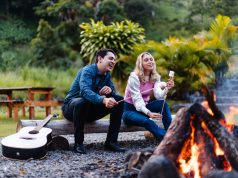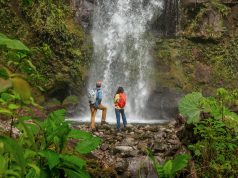You will discover the most valuable coffee in the world, forest parks and amazing marine destinations
Its first settlers – the Guaimi – called these lands “Chiriqui” or “Cherique”, which means “Moon Valley”. It was first mentioned on the fourth voyage of Christopher Columbus in 1502, recounted in the Chronicles of Ferdinand Columbus according to scholar Phillip Young.
Historically, the Spanish captain Gaspar Espinosa is mentioned as the one who discoverer and conquered Chiriqui in 1519. When colonization started the first towns emerged: Remedios, Alanje, David, San Felix, Tole, San Lorenzo, Dolega, Gualaca, Boqueron and Bugaba among the years 1589 – 1794. After hundred years of the creation of Chiriqui (1949), other institutions emerged such as Boquete, Remedios, Progreso, Volcan, Dolega, Gualaca and Manaca. Located in western Panama, it is the province that borders Costa Rica, and is at more than 400 kilometers away from Panama City. It is the most fruitful region of the country in terms of agricultural production, and most biodiverse area due to the great amount of species of flora and fauna that can be observed in its environment. This area of the country is very attractive for tourism for both locals, European, Central American and northern visitors. It is distinguished by its contrasting geographical characteristics, with flat coastlines suitable for fishing and mountains that exceed three thousand meters in height.
Puerto Armuelles
This rural fishing village is the head city of the Baru district. It has a population of 18,795 citizens and is also known as AML, Puerto Armuelles. It is the furthest city from Panama City (approx. 550 km.) and is popularly known as “Ciudad de las Arenas” (City of sands). One of its particular characteristics is that it is the only city in Chiriqui with a sandy coastline suitable for recreation.
This small city with a history linked to the banana industry has kilometers of beach that border the city with nothing to obstruct the view. This town was designed facing the sea, and soon the construction of a new pier that will attract small cruise ships, and a Coastal Walk will begin.

Gulf of Chiriqui
On the extreme northwestern part of the Panamanian Pacific, near the border with Costa Rica, is the Gulf of Chiriqui, which extends along the Pacific coast to the Azuero Peninsula. It has one of the largest coral reefs in the Pacific, dense mangrove forests and Coiba Island, the largest in the country. It has protected areas such as the Gulf of Chiriqui National Marine Park (1994), a 150 square kilometers area where Secas, Los Ladrones, Parrillas and Montuosa Islands are located. It houses part of the Coiba National Marine Park.
To explore its islands of volcanic origin, you must reach Boca Chica, a fishing village recommended for lodging and whose hotel offer begins to have a vertiginous development. From this point you can arrive by boat to the National Marine Park. Among the most popular tours are visiting Islas Secas, Islas Paridas and Paridita, Islas Palenque with its 162 hectares of tropical jungle, with a hotel of the same name. There is also Isla Bolaños with four beaches lined with coral reefs among others.
The Gulf of Chiriquí is one of the best places in the world to go fishing to catch marlins, with specimens weighing around 200 kilos. Sailfish, 50-pound snappers can be caught, especially on Montuosa Island and Hannibal Bank. It is also ideal for the sighting of species where parrot fish, trumpet fish, sea turtles, dolphins, manta rays, hammerhead sharks, humpback and pilot whales stand out in their breeding season between August and December.
Highlands (Tierras Altas)
Among the most visited places are Cerro Punta, Volcan, Boquete, coffee farms, orchid tours, horseback riding, trails and National Parks, among which La Amistad International Park stands out, in a border protected area. between Panama and Costa Rica, declared a World Heritage Site (UNESCO 1983). In this enclosure, trails such as Panama Verde (400 m), El Retoño (2.4 km.) and Sendero La Cascada (6 km.), the Sendero de los Puentes in the Talamanca mountain range, which borders the La Amistad International Park, (4.5 km.), where you can visit six suspension bridges between trees.

The summit of the volcano is the highest point in Panama (3,478 m). You can walk to the top or buy packages to get there with all terrain vehicles. There are other less extensive routes such as Punta Escondida or Las Flores. One of the most requested tours is the Los Quetzales trail (between Cerro Punta and Boquete – 18 km. round trip). Only in both parks are lodged 60% of the birds of Panama.

Coffee Farms
Agrotourism gains greater popularity due to the Coffee Circuit concept, which includes the activation of 18 coffee farms located in Renacimiento, Tierras Altas and Boquete to this initiative. Harman, Grupo Eleta, Apre and Candela, Renacimiento district; Janson, Ceriana, Carmen Estate Coffee, Nueva Suiza, Hermanos Lara and Bambito Estate Coffee in the Tierras Altas district; Boquete TreeTrek, Kotowa, Lerida, Elida, Princesa Janca, Cafe Ruiz, La Milagrosa, Don Pepe and Hacienda Mamecillo, in the Boquete district. In each farm you will be able to know the facilities, the areas where the best coffee beans are planted, harvested, stored and processed.
In these routes, tourists will even be able to taste a delicious cup of coffee, all while getting to know the peasant who carries out this difficult task. You can also learn to distinguish the different types of coffee with tasters.
In the future, more than 40 farms are expected to participate. Much of this tourist boom is due to the fact that many fans of this drink and its derivatives want to know where the most valuable coffee in the world is produced: Geisha.
In general, all hostels and hotels offer packages for a Coffee Tour, which often include other attractions such as bird watching, access to zip lines over these farms, among others.

David
It is the capital and head city of the district that bears the same name. It ranks second in population in the country (140,000 inhabitants) and is the fourth largest city in Panama. It is only an hour from Paso Canoa, the border with Costa Rica.
David City is the first to have an urban planning plan since 2004 and to which they are giving continuity by finally being approved in 2016. The plan was designed by the Brazilian architect Jaime Lerner (RIP), creator of the “miracle city of Curitiba” in Brazil. This plan deals with an urban center with a fairly suburban grid layout to function as an intermediary center between the tourist and rural agricultural areas of the western region.
In the city of David there are places to visit such as the Miguel de Cervantes Saavedra Park, a kind of prelude for its visitors, with its tenants, the large iguanas that dominate this recreational space. Nearby, there is the great Church “La Sagrada Familia”, important shopping centers and in the middle of the park, a triangular shaped obelisk bathed by several water fountains.
Another tourist spot that is being rebuilt is the David Old Town, or Barrio Bolivar, where you can see the Parque Bolivar in honor of Simon Bolivar. There you can see the San Jose Cathedral of David with its own European façade from 1,837, but currently, the only original thing is the tower of the Cathedral. The city of David bets more on historical tourism to rescue its cultural heritage.

Things to Do
Go on a Coffee Tour in the Highlands and Boquete. Hotels offer a package for you to visit the nurseries, coffee plantations, learn about the harvest, roasting and packaging, in addition to tasting the final result. Prices range from $25.00 for a short ride to $40.00, depending on the number of people.
Take a boat to explore the Gulf of Chiriquí and get to know this region. You can visit Isla Gamez and Bolaños (in addition to include Isla Parida), Islas Secas – Boca Chica, participate in dolphin or whale watching groups. Information: www.bocabravaadventures.com
Learn all about El Chorogo forest that extends about 10 kilometers on a strip of the Burica peninsula, on the Panamanian border side. This private enclosure is the only place in the country where 12 species of birds globally restricted to the Endemic Bird Area of South Central America can be found. Information: www.audubonpanama.org
Visit David’s Old Town, located in the Bolívar neighborhood. In it you will find points of historic interest such as the San Jose de David Cathedral, the Jose Domingo de Obaldia Museum of History and Art, the Simon Bolivar Park, the Gallegos Foundation, dedicated to preserving the heritage of David and the province.
Relax at Los Limones beach, at 45 minutes from Puerto Armuelles. There you will find the “Aqua Adventures Panama Inc.” Tourist Center, a set of cabins where you can stay and purchase one of their sport fishing packages. Call (507) 6672-9168

















